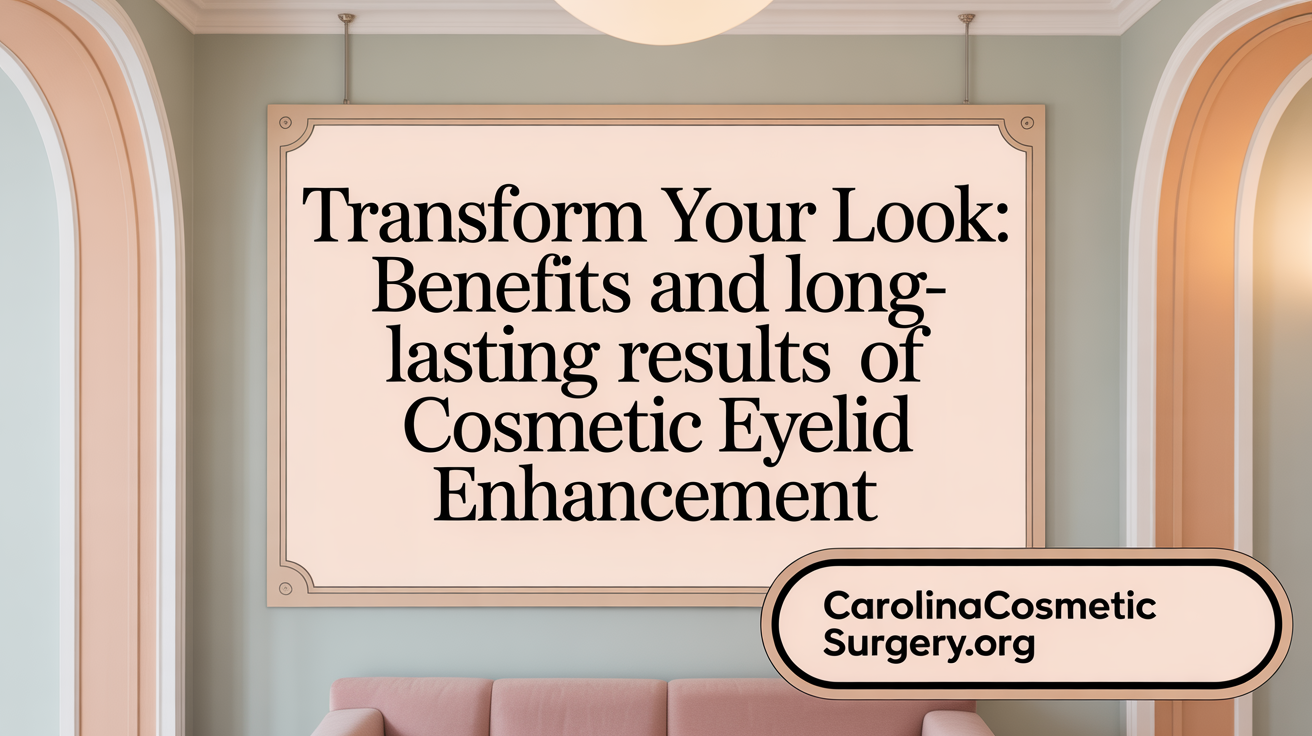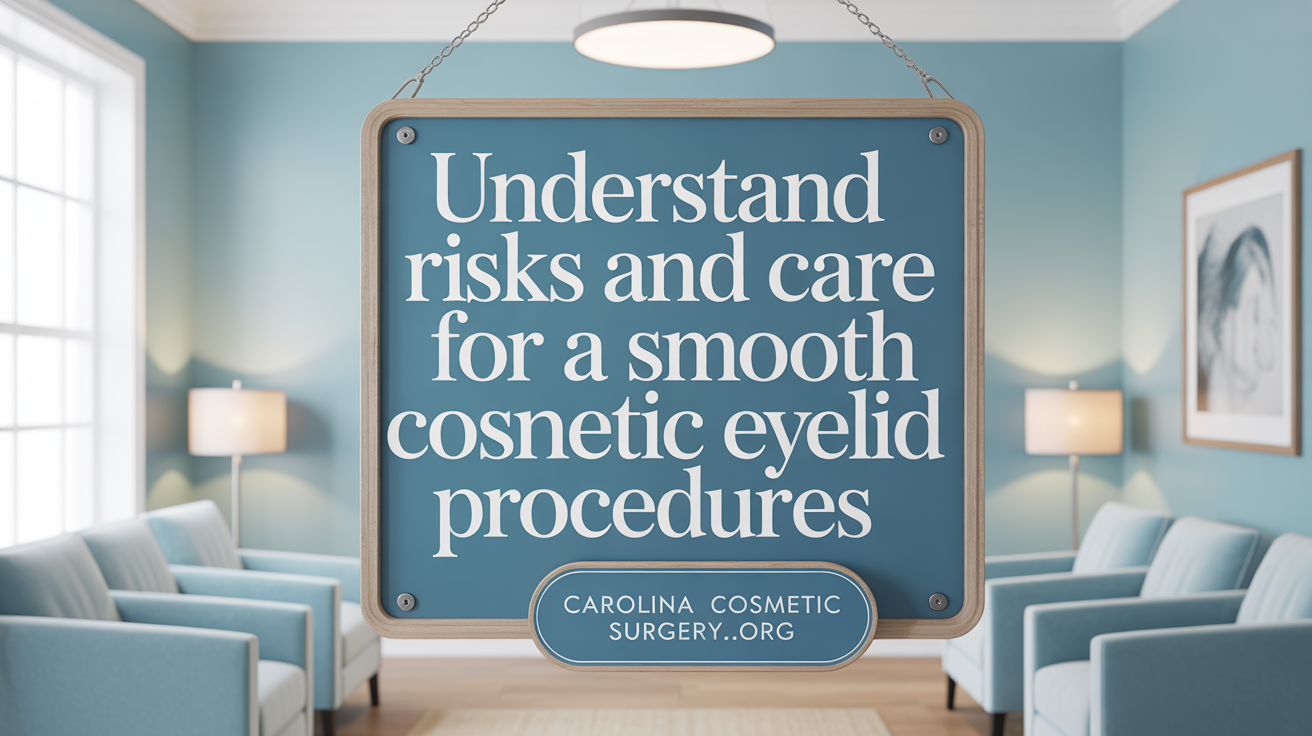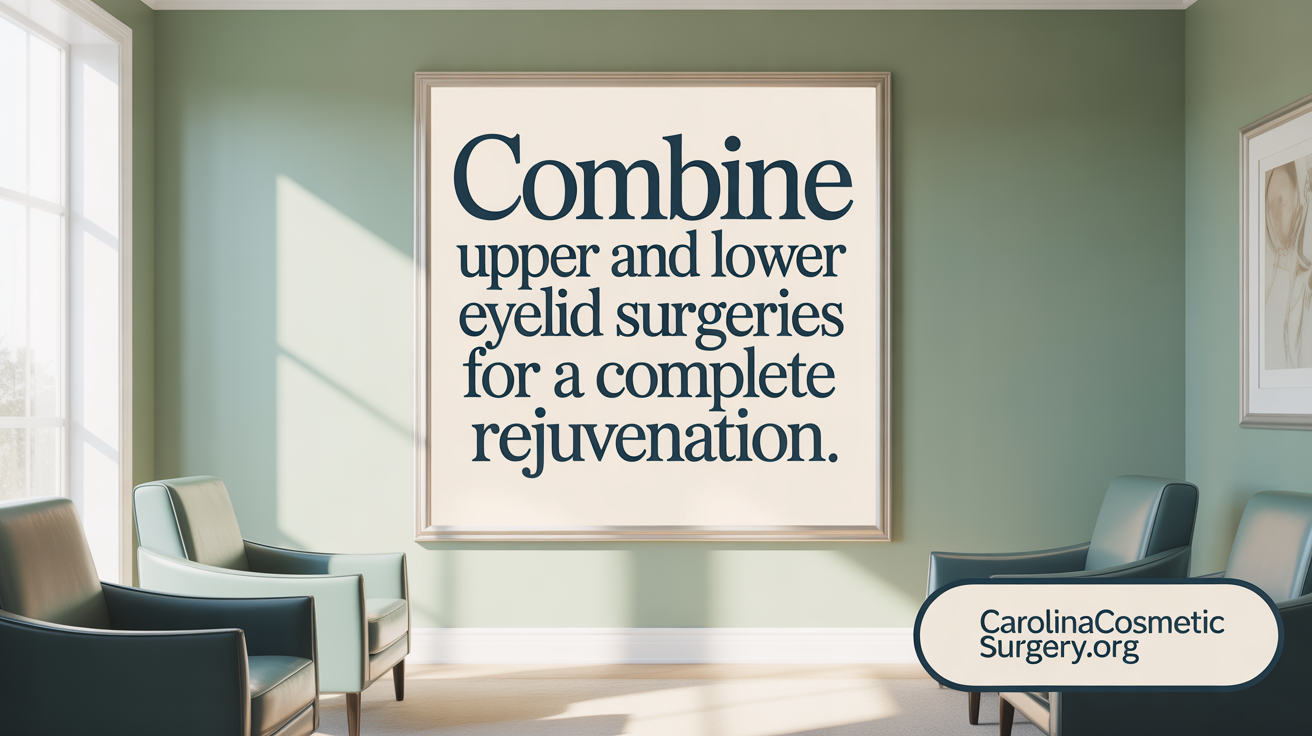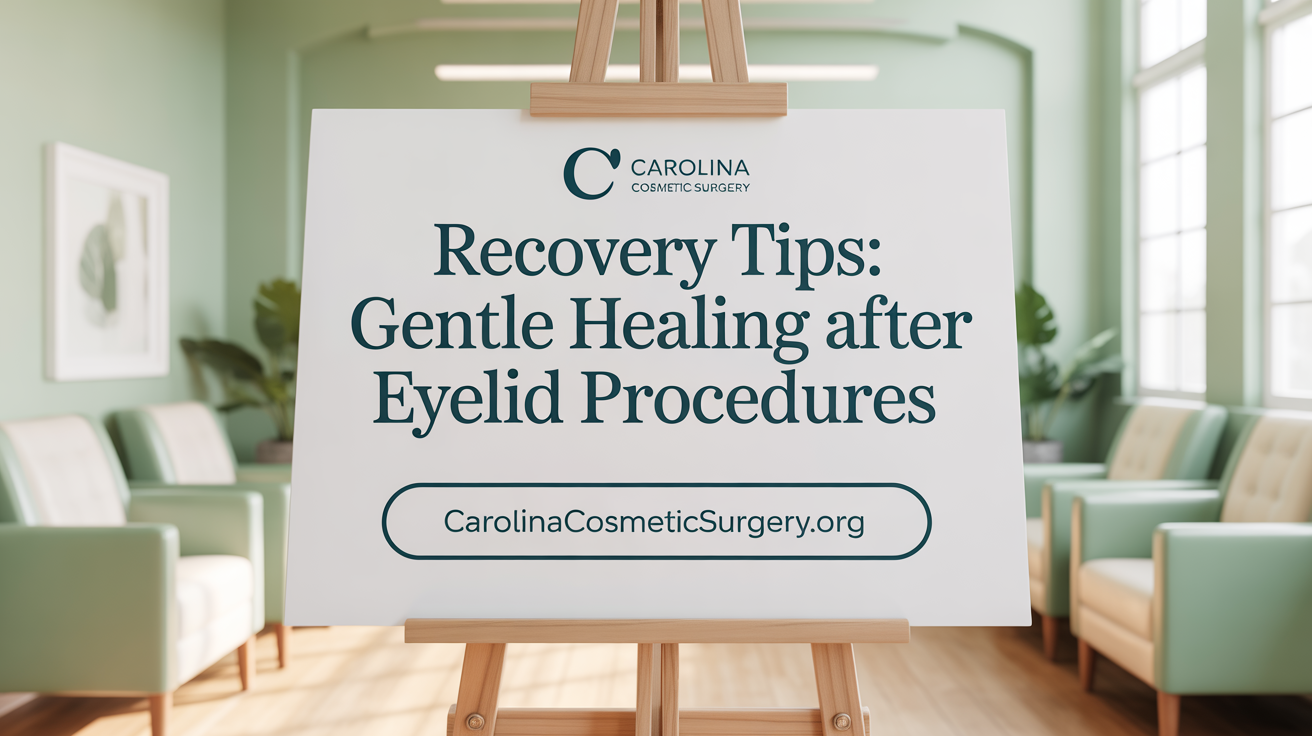Introduction to Eyelid Surgery
Eyelid surgery, or blepharoplasty, is a popular cosmetic and functional procedure designed to rejuvenate the eye area. While upper and lower eyelid surgeries share the common goal of delivering a refreshed and youthful appearance, they differ significantly in techniques, objectives, and the concerns they address. This article explores these fundamental distinctions to help readers understand which procedure might be best suited to their needs and expectations.
Key Facts List: Eyelid Surgery - Upper and Lower Blepharoplasty
- Upper eyelid surgery aims to remove excess skin, fat, and muscle to improve appearance and vision.
- The incisions are made within the natural eyelid crease for minimal scarring.
- Ideal candidates are those with drooping eyelids impairing vision or a tired appearance but with good health.
- Recovery from upper blepharoplasty generally takes 1-2 weeks with swelling and bruising peaking early.
- The main goal of lower eyelid surgery is to address puffiness, bags, and wrinkles, improving under-eye contour.
- Techniques include the transcutaneous approach (external incision) and transconjunctival approach (inside the eyelid).
- Candidates for lower blepharoplasty are healthy individuals with puffiness, dark circles, or hollowing who have realistic expectations.
- Risks of lower eyelid surgery include ectropion, dry eyes, swelling, bruising, and rare vision issues.
- Combining upper and lower eyelid surgeries offers comprehensive rejuvenation, with single recovery period.
- Recovery from combined eyelid surgery takes 1-3 weeks, with initial swelling and bruising gradually subsiding and full results visible over several months.
1. Upper Eyelid Surgery: Elevating Vision and Appearance
What is the purpose of upper eyelid surgery?
Upper eyelid surgery, also known as blepharoplasty, primarily aims to remove excess skin, fat, and sometimes muscle from the upper eyelids. This procedure helps correct drooping, sagging eyelids, and can significantly enhance both appearance and function. Many patients seek this surgery to achieve a more alert and youthful look, but it also offers the benefit of improving vision if sagging eyelid skin obstructs the sight.
How are surgical techniques and incisions placed?
The surgery involves making a small incision within the natural crease of the upper eyelid. This strategic placement ensures that scars are minimal and easily hidden once healed. Surgeons may remove or reposition excess fat, trim sagging skin, and tighten muscles if necessary. The approach is designed to preserve eyelid function while lifting and rejuvenating the eyelid area.
Who is suitable for upper blepharoplasty?
Candidates typically include individuals experiencing drooping eyelids that may impair vision, eyelid skin hanging over the lashes, or a tired, sad appearance. Good general health and realistic expectations are essential. Patients should not have underlying eyelid or eye diseases, and those with significant dry eye symptoms or systemic conditions like thyroid issues should first consult with a healthcare provider.
What benefits and outcomes can patients expect?
Following the procedure, patients usually notice a more open, refreshed look. The eyelids appear tighter, and the natural contours are restored, resulting in a more alert expression. In cases where sagging eyelids hinder vision, significant improvement can be observed. Scarring is typically concealed within the eyelid crease, making the results discreet.
What are recovery expectations?
Recovery from upper blepharoplasty generally spans 1 to 2 weeks. Swelling and bruising are common initially, peaking within the first few days. Most patients can return to work and normal activities within this period, although strenuous activities should be avoided briefly. Complete healing, including the fading of swelling and the settling of tissues, takes several weeks. Proper care, including cold compresses and following post-operative instructions, helps ensure optimal healing.
2. Lower Eyelid Surgery: Renewing the Under-Eye Contour
What is the main purpose of lower eyelid surgery?
Lower eyelid surgery, also known as lower blepharoplasty, primarily aims to enhance the appearance of the area beneath the eyes. It addresses common signs of aging such as puffiness, under-eye bags, fine lines, wrinkles, and hollowing. The goal is to create a smoother, more rested, and youthful look, improving the overall facial harmony.
What techniques are used in lower eyelid surgery?
Lower blepharoplasty can be performed using two main surgical approaches:
- Transcutaneous approach: An incision is made just below the lower eyelashes. This allows surgeons to remove or reposition excess fat, tighten the skin, and sometimes remove additional skin for a more significant correction.
- Transconjunctival approach: An incision is made inside the lower eyelid (conjunctiva), which is hidden from view. This technique is ideal for patients with fat protrusion and minimal skin laxity, as it allows for fat removal or repositioning without external scars.
Both methods are tailored to the individual's specific needs, with the choice depending on the severity of excess fat, skin laxity, and aesthetic goals.
Who is suitable for lower blepharoplasty?
Candidates for lower eyelid surgery generally have concerns about under-eye puffiness, bags, or dark circles that do not improve with skincare or lifestyle changes. They should be in good overall health, with realistic expectations about the results. Patients should have stable weight and no active eye or systemic health issues that could interfere with healing.
Are there vision improvements or aesthetic limits?
While upper eyelid surgery can sometimes improve peripheral vision that is obstructed by drooping eyelids, lower eyelid procedures are focused on cosmetic enhancements. Lower blepharoplasty does not typically affect vision but improves the contour under the eyes. In some cases, extensive skin laxity or structural issues may limit aesthetic outcomes, making a combination with other facial procedures advisable.
What should patients consider regarding recovery and potential risks?
Recovery from lower eyelid surgery usually takes about 2 to 3 weeks. Swelling and bruising are common initially but gradually subside. Patients are advised to rest and limit strenuous activities during this period.
Possible complications include swelling, bruising, dry eyes, infection, bleeding, eyelid malposition such as ectropion, or persistent puffiness. Less common risks involve scarring or alterations in eyelid sensation.
Choosing an experienced surgeon can significantly reduce the risk of complications. Proper preoperative assessment, especially of eyelid anatomy and underlying health, is essential for optimal results.
What are the typical procedures and techniques used in upper versus lower blepharoplasty?
Lower blepharoplasty often uses an external incision just below the lash line or a transconjunctival approach inside the eyelid to remove or reposition excess fat, tighten skin, and address puffiness, under-eye bags, wrinkles, and dark circles. Unlike upper blepharoplasty, which can improve vision, lower eyelid surgery primarily focuses on cosmetic rejuvenation.
Who Are Ideal Candidates for Upper and Lower Eyelid Surgery?

Who are suitable candidates for upper and lower eyelid surgery?
Ideal candidates for eyelid surgery are generally healthy individuals who experience specific concerns with their eyelids. For upper eyelid surgery, or upper blepharoplasty, candidates typically have excess skin on the upper eyelids that causes drooping, heaviness, or obstructs vision. They might also have fat deposits that contribute to a sagging appearance. For lower eyelid surgery, or lower blepharoplasty, candidates often seek to address under-eye bags, puffiness, dark circles, or fine lines that give a tired look.
It’s important that candidates do not have serious eye conditions or systemic health issues that could complicate surgery or healing. Non-smokers tend to recover better, as smoking can impair wound healing. Additionally, individuals should have realistic expectations about the results and understand the recovery process.
Patients who seek both cosmetic enhancement and improved functional vision, especially when drooping eyelids interfere with sight, might choose to undergo both procedures simultaneously for a comprehensive rejuvenation.
Health and medical suitability
Candidates should undergo a thorough evaluation, including eye health assessments and medical history reviews. Conditions like dry eyes, thyroid issues, or other systemic diseases may require special considerations.
Preoperative tests, such as Schirmer’s test for tear production or visual field testing, help ensure the patient’s safety and suitability for surgery.
Age and lifestyle factors
Typically, patients in their 40s and older seek eyelid surgery as normal signs of aging become prominent. However, younger individuals with congenital hooding or significant eyelid swelling due to other conditions may also be candidates.
Lifestyle habits, such as smoking or excessive alcohol consumption, can affect healing and should be discussed during consultation.
Specific signs warranting each surgery
Signs indicating the need for upper eyelid surgery include eyelid skin hanging over the lashes, difficulty applying makeup due to eyelid creases, a tired or sad appearance, and visual field impairment caused by drooping lids.
For lower eyelid surgery, signs include persistent under-eye bags or puffiness, dark circles, hollowing or tear troughs, and a generally tired or aged appearance despite adequate sleep.
Ultimately, an assessment by a qualified surgeon will determine the best approach tailored to each individual’s concerns and anatomy.
Benefits and Outcomes of Upper and Lower Eyelid Surgery

What are the benefits and outcomes associated with upper and lower eyelid surgery?
Eyelid surgeries, both upper and lower, are designed to revitalize the eye area, delivering noticeable aesthetic and functional improvements. Upper eyelid surgery, known as blepharoplasty, primarily removes excess skin and fat from the upper lids. This results in a more open, alert, and youthful appearance, while also potentially improving peripheral vision if sagging eyelids obstruct sight.
Lower eyelid surgery addresses issues beneath the eyes, such as puffiness, under-eye bags, dark circles, and fine wrinkles. It creates a smoother, brighter under-eye area that gives the face a more rested and rejuvenated look. Many patients notice a significant reduction in tiredness and an overall enhancement to facial harmony.
Both procedures typically provide long-lasting results, often maintaining their effects for ten years or longer when combined with good skincare and healthy habits. The outcomes boost self-confidence, helping individuals feel more vibrant and alert in their daily interactions.
Performing both surgeries simultaneously can offer comprehensive facial rejuvenation. This approach results in harmonious improvements across the entire eye area and face, with a single recovery period—making it an efficient option for those seeking a complete refresh.
These procedures not only enhance appearance but can also have positive psychological effects, improving social interactions and self-esteem. Patients often feel more comfortable and confident, which can influence their personal and professional lives positively.
In summary, upper and lower eyelid surgeries deliver durable, noticeable improvements, combining cosmetic clarity with potential functional benefits, and contribute to overall well-being by rejuvenating the eye area and restoring a youthful, refreshed look.
Potential Complications and Recovery Considerations

What are the potential complications and considerations specific to lower blepharoplasty?
Lower eyelid surgery, or lower blepharoplasty, can achieve a more youthful appearance by reducing under-eye bags, puffiness, and wrinkles. However, like any surgical procedure, it carries certain risks that need to be considered.
One common concern is ectropion, where the eyelid turns outward out of its normal position. This can cause dryness, irritation, or exposure of the eye if untreated. Additionally, some patients may experience dry eyes due to alterations in eyelid function or muscle tightening.
Bruising and swelling are typical after the procedure, generally peaking within the first week but lasting for a few weeks as healing progresses. Scar formation is usually minimal because the incisions are placed either inside the eyelid (transconjunctival approach) or discreetly below the lash line. These scars tend to become almost invisible over time.
Serious complications are rare but potentially severe. These include infection, bleeding, or even vision loss if complications involve retrobulbar hemorrhage. Proper preoperative assessment and experienced surgical technique are essential to minimize these risks.
Scarring and healing timeframes
Postoperative healing largely depends on individual health, age, and adherence to care instructions. Typically, initial swelling and bruising diminish within 2-3 weeks. Patients are usually able to return to normal activities after this period, though residual swelling may take longer to resolve completely.
The scars from lower eyelid surgery are usually hidden within the natural eyelid fold or along the lash line. Over months, these scars fade significantly, becoming very discreet.
Specific concerns for lower blepharoplasty
Patients should be aware of the unique issues that can arise with lower eyelid surgery. For instance, if the skin removal is too aggressive or uneven, it can lead to a hollowed or “sunken” look.
Another point is the potential for eyelid malposition, such as ectropion, especially in patients with preexisting eyelid laxity or medical conditions like eyelid laxity or previous surgeries. Careful assessment and surgical planning are crucial to avoid such outcomes.
Patients with preexisting dry eyes, autoimmune conditions, or systemic diseases like diabetes or thyroid disorders need thorough evaluation before surgery. Postoperative follow-up is essential to managing complications promptly.
In summary, while lower blepharoplasty can smooth and rejuvenate the under-eye area, it requires a skilled surgeon and careful patient management to avoid and address potential complications effectively.
Can Upper and Lower Eyelid Surgeries Be Combined?

What are the advantages of combining upper and lower eyelid surgery?
Combining both procedures allows for a comprehensive approach to facial rejuvenation, addressing multiple aging signs around the eyes in one surgical session. This not only creates a more harmonious and natural appearance but also maximizes results by simultaneously lifting drooping eyelids and smoothing under-eye bags and wrinkles.
Patients often find combined surgery more convenient because it consolidates recovery and reduces the need for multiple procedures. The overall cost can also be lower than undergoing separate surgeries, and the results tend to be more balanced, rejuvenating the entire eye area effectively.
How does combining procedures improve surgical and recovery efficiency?
Performing upper and lower eyelid surgeries together means patients experience a single anesthesia session, reducing overall operative risks. Recovery time is streamlined as swelling and bruising tend to peak at similar times, allowing for a unified healing process. Patients can potentially return to normal activities faster, with fewer disruptions, as opposed to undergoing two separate recoveries.
Doctors carefully plan combined surgeries to manage swelling and ensure optimal healing, often resulting in better aesthetic outcomes and fewer inconvenience.
Who is suitable for combined blepharoplasty, and what are expected results?
Ideal candidates are those exhibiting signs of aging both above and below the eyes. They typically have excess skin on the upper eyelids causing hooding and drooping, along with puffiness or under-eye bags.
Candidates should be in good overall health, with realistic expectations about the outcomes. Dr. Ahn, with over 20 years of experience, has developed techniques that allow for less invasive incisions and quicker recovery, making combination procedures more feasible and comfortable.
Expected results include a more alert, youthful look, improved peripheral vision if drooping eyelids previously obstructed sight, and a balanced facial appearance. Most patients see results lasting 10 years or longer.
| Aspect | Benefits | Additional Details |
|---|---|---|
| Procedure | Addresses both upper and lower eyelids | Done in one session |
| Recovery | Single period of healing | Swelling and bruising peak early |
| Cost | Often more economical | Combines two surgeries into one |
| Results | Harmonious rejuvenation | Fades over about a decade |
Considering the benefits, many patients choose to combine both treatments for a more comprehensive facial refreshment, ensuring they enjoy a natural, youthful appearance while minimizing overall recovery and expenses.
Typical Recovery Process After Combined Eyelid Surgery

What is the typical recovery process after combined upper and lower blepharoplasty?
Recovery from both upper and lower eyelid surgeries generally takes between one to three weeks. During the initial days, swelling and bruising are common and tend to peak within the first few days post-surgery. Patients often notice the most noticeable swelling and bruising during this period, which gradually improve over time.
Within 10 to 14 days, most of the swelling and bruising begin to diminish, allowing individuals to return to their regular daily activities. However, complete healing, including scar maturation and the final aesthetic results, can take several months and, in some cases, up to a year. This extended healing period allows the incisions, typically placed within natural creases or discreet areas, to fade into the skin.
Postoperative care is essential for smooth recovery. Patients are advised to keep their head elevated, especially while sleeping, to reduce swelling. Applying cold compresses or ice packs during the first 48 hours can help minimize swelling and bruising. It’s also important to avoid strenuous activities, heavy lifting, and vigorous facial movements during the initial recovery phase.
Sutures are usually removed within the first week, depending on the surgeon's standard protocol. Patients should carefully follow their surgeon's instructions regarding cleaning and caring for the incision sites to prevent infection and promote optimal healing.
While the majority of recovery occurs within the first two weeks, residual swelling and minor asymmetries may persist slightly longer. Full results, including the final refined appearance and scar maturation, are typically visible after several months, with optimal aesthetic outcome achieved around the one-year mark.
Making an Informed Choice Between Upper and Lower Eyelid Surgery
Choosing between upper and lower eyelid surgery depends on individual anatomy, aesthetic goals, and functional needs. Upper eyelid surgery is ideal for those seeking to correct sagging lids and improve vision, while lower eyelid surgery addresses cosmetic concerns like puffiness, bags, and wrinkles beneath the eyes. Consulting a qualified surgeon helps tailor an approach that may include one or both procedures for optimal rejuvenation. With proper care and realistic expectations, patients can enjoy lasting improvements that refresh their appearance and confidence.
References
- Upper vs. Lower Blepharoplasty: Which Type of Eyelid Surgery Is ...
- Upper vs Lower Blepharoplasty: Comparison & Considerations
- Upper vs Lower Eyelid Blepharoplasty | Irvine, CA
- Upper vs. Lower Blepharoplasty: How To Know Which One You Need
- The Difference Between Upper and Lower Blepharoplasty
- Is Cosmetic Blepharoplasty Right for You? | Dr. Malena M. Amato
- Upper And Lower Eyelid Surgery Differences
